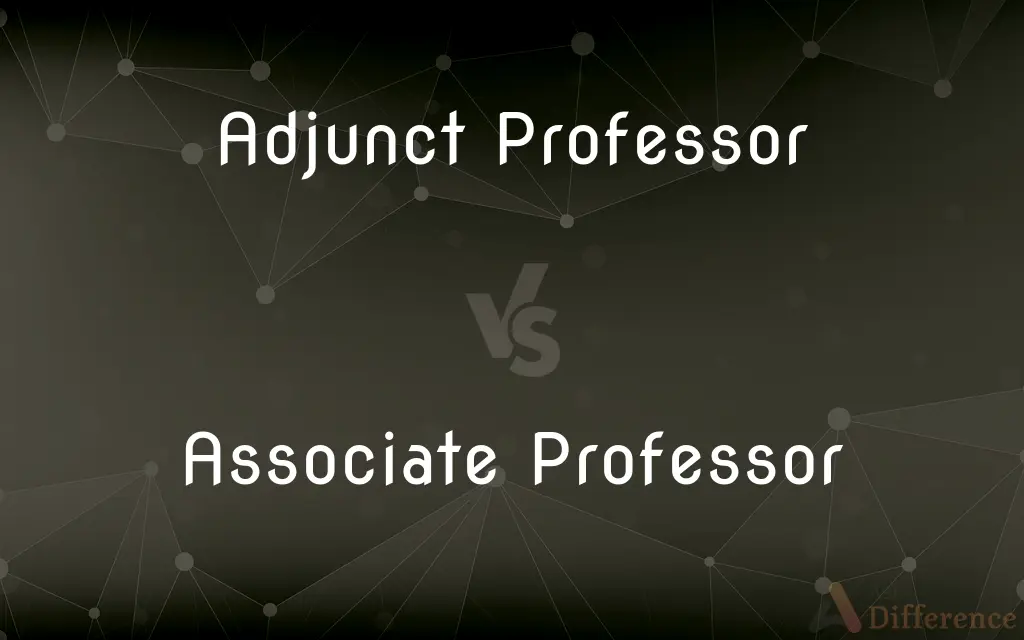Adjunct Professor vs. Associate Professor — What's the Difference?
By Maham Liaqat & Urooj Arif — Published on February 23, 2024
An adjunct professor is a part-time instructor hired on a contractual basis, often without benefits, while an associate professor is a full-time faculty member with a path to tenure, often engaged in teaching, research, and service.

Difference Between Adjunct Professor and Associate Professor
Table of Contents
ADVERTISEMENT
Key Differences
Adjunct professors and associate professors differ significantly in their roles, job security, and responsibilities within academic institutions. Adjunct professors are typically hired to teach specific courses, providing practical industry knowledge or expertise in a particular subject area. They are often employed on a part-time, temporary basis, with contracts that may be renewed each semester or academic year. This position does not usually include a path to tenure, and adjuncts are often paid on a per-course basis without the benefits (such as health insurance or retirement plans) that full-time faculty receive.
Associate professors, on the other hand, hold a higher, more stable position within the academic hierarchy. They have usually been granted tenure or are on the tenure track, which provides them with job security and the expectation of a long-term commitment to the institution. This role involves a balance of teaching, research, and service to the university, including committee work and advising students. Associate professors are expected to contribute to their academic field through research and publications, and they often have a significant influence on curriculum development.
The path to becoming an associate professor typically involves a rigorous evaluation process that assesses the individual's contributions to research, teaching effectiveness, and service to the academic community. This process can take several years and usually requires the achievement of certain milestones, such as the publication of scholarly work and successful teaching evaluations.
The hiring of adjunct professors is more focused on immediate teaching needs rather than long-term academic contributions. Institutions may rely on adjuncts to provide flexibility in course offerings or to fill gaps in the curriculum that arise from the research sabbaticals or leaves of absence of full-time faculty.
The distinction between these roles highlights the diverse nature of academic employment and the varying levels of commitment and contribution expected from faculty members. While adjunct professors can offer valuable real-world perspectives and enhance the practical aspects of education, associate professors contribute to the foundation and growth of academic programs and the institution's research profile.
ADVERTISEMENT
Comparison Chart
Employment Type
Part-time, contractual
Full-time, often tenure-track or tenured
Responsibilities
Teaching specific courses
Teaching, research, service to the university
Job Security
Limited, contract-based
High, with tenure or on tenure track
Benefits
Usually none (e.g., health insurance, retirement plans)
Includes full benefits package
Path to Tenure
No direct path
Tenure-track with a path to permanent tenure
Academic Contribution
Focused on teaching
Balanced among teaching, research, and service
Salary
Paid per course or semester
Fixed annual salary with potential for grants and research funding
Role in Curriculum Development
Limited
Significant, with involvement in committee work and advising
Compare with Definitions
Adjunct Professor
May work at multiple institutions.
The adjunct professor taught similar courses at two different colleges.
Associate Professor
Involved in teaching, research, and service.
The associate professor balanced lecturing with her research projects.
Adjunct Professor
Provides industry or specialized expertise.
An adjunct professor in cybersecurity shared current field practices.
Associate Professor
Influential in academic and departmental decisions.
She used her position as an associate professor to advocate for policy changes.
Adjunct Professor
A part-time faculty member hired to teach specific courses.
The adjunct professor brought real-world experience to the business course.
Associate Professor
A full-time faculty member on the tenure track.
After publishing her book, she was promoted to associate professor.
Adjunct Professor
Often lacks job security and benefits.
As an adjunct professor, she negotiated her contracts each semester.
Associate Professor
Has job security and benefits.
As an associate professor, he appreciated the stability and health insurance.
Adjunct Professor
Hired based on teaching needs.
He was hired as an adjunct professor to cover a leave of absence.
Associate Professor
Plays a role in curriculum development.
The associate professor chaired the committee revising the curriculum.
Common Curiosities
Are associate professors tenured?
Associate professors are often on the tenure track or have already achieved tenure, providing them with job security and a permanent position.
Can an adjunct professor become an associate professor?
Yes, but it requires a significant shift in role, typically involving a new application process, increased responsibilities, and meeting the criteria for tenure-track positions.
What is the tenure process like for associate professors?
The tenure process involves a rigorous review of the professor's research, teaching, and service contributions, usually over a period of several years.
Do adjunct professors participate in research?
While they can, adjunct professors are not typically hired for or expected to engage in research activities as part of their contractual duties.
What benefits do associate professors have that adjunct professors do not?
Associate professors usually receive a full benefits package, including health insurance, retirement plans, and potential for research funding, unlike adjuncts.
How do institutions decide between hiring an adjunct or an associate professor?
Decisions are based on the institution's needs, budget, and long-term goals, with adjuncts filling immediate teaching gaps and associates contributing to the core academic mission.
What is the primary difference between an adjunct and an associate professor?
The primary difference lies in employment status and responsibilities: adjuncts are part-time and focus on teaching, while associates are full-time with a broader range of responsibilities including research.
Is it common for adjunct professors to have other jobs?
Yes, due to the part-time nature and often lower compensation of adjunct positions, many adjuncts work multiple jobs or roles.
How does the role of an adjunct professor benefit students?
Adjunct professors can provide current industry insights and practical expertise, enhancing the real-world relevance of the curriculum.
Why do some choose to be adjunct professors despite the lack of job security?
Reasons include passion for teaching, desire for flexibility, gaining teaching experience, or complementing other professional activities.
Share Your Discovery

Previous Comparison
Cosmetologist vs. Makeup Artist
Next Comparison
Elastic Modulus vs. Young’s ModulusAuthor Spotlight
Written by
Maham LiaqatCo-written by
Urooj ArifUrooj is a skilled content writer at Ask Difference, known for her exceptional ability to simplify complex topics into engaging and informative content. With a passion for research and a flair for clear, concise writing, she consistently delivers articles that resonate with our diverse audience.
















































